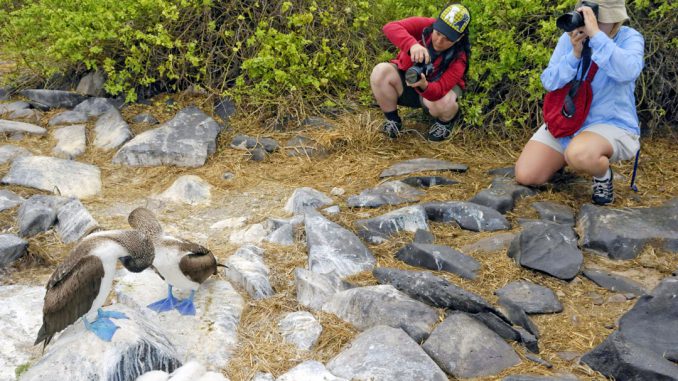
Embrace birdwatching as a pleasurable pastime at home and abroad
Spring and fall are known for migratory birdwatching in Canada, but birding is a year-round activity both at home and around the world. Whether you’re an amateur or an ardent devotee, observing birds as an individual or in a group, the experience will enhance your enjoyment of the natural environment.
Here’s a roundup of some of our favourite domestic and international destinations for viewing our fine feathered friends.
Birdwatching around the world
Avian life abounds on every continent. National, provincial and state parks are popular places for birdwatching, as well as wildlife refuges and sanctuaries.
Our first birding tour was in the Caroni Bird Sanctuary in Trinidad, where thousands of scarlet ibis inhabit the swamp. One look at the brilliant red plumage of Trinidad’s national bird hooked us on the avian pursuit.
A more legendary bird − the resplendent quetzal − drew us to Costa Rica’s Savegre Forest Reserve, 90 kilometres southwest of San José. The sacred bird of the Mayas and Aztecs, the quetzal is now endangered, the victim of a rapidly diminishing cloud forest habitat.
The pigeon-sized male displays two graceful tail feathers nearly twice the length of its body. A crimson breast contrasts vividly with its lustrous green plumage.
When we joined a tour at Savegre Hotel, we received a checklist of 170 bird species. After four hours of hiking, we returned to the hotel with checkmarks next to 80 birds − but no quetzal.
To our surprise, we noticed several birdwatchers peering into scopes, gazing at a splendid male quetzal just metres from our lodging. He let us admire him for a few precious minutes and then vanished like an apparition, leaving only the glint of the sun on his luminous green tail feathers.
Numerous trails in Everglades National Park, an hour from Miami, offer opportunities to view more than 300 bird species. From the Eco Pond Trail, we observed several snowy egrets.
On the Anhinga Trail boardwalk through a sawgrass marsh, we spotted an anhinga, perched on a branch holding its wings out to dry like a cape. (Anhingas’ feathers lack oil, so they must dry them after fishing before they can fly again.)
Look up! Look down!
At Sable Island National Park Reserve, a 70-minute flight southeast of Halifax, we learned to look skyward as well as on the ground to appreciate the 350 bird species found here.
Herring gulls soared above us and cautiously watched us from their nests on the sand. By our feet, we spotted herring gull footprints and a broken-open gull egg, speckled with brown, grey and black spots.
Sable Island has two colonies of roseate terns, which also nest on the ground. They are listed as endangered in Canada, with fewer than a dozen breeding pairs.
Angry birds − not the online game
When we viewed Main Station, near the location of one colony, Parks Canada staff did not allow us to approach the buildings. “Terns nesting in the heath will dive-bomb you if you get too close. They aggressively protect their nests from people who may trample them and from gulls that try to eat their eggs.”
In northern Manitoba, we also had to scan the ground carefully to see ptarmigans eating seeds from tiny bushes. With plumage as white as the snow around them, we could only see the birds when they moved their black eyes and beaks.
No binoculars or telephoto lenses?
No problem − if you’re in the Galapagos. Located 1,000 kilometres west of Ecuador, the archipelago requires all visitors to Galapagos National Park to use certified naturalists as guides.
“Stay at least two metres away from wildlife,” advised our guide Ceci. “If birds or animals approach closer, don’t touch them. They’re not tame, just unafraid.”
From that distance, you can still take awesome photos, even with smartphone cameras.
Cute chicks
October on Espanola Island is a perfect time for birdwatching, because adults and albatross chicks are in their nests. Albatrosses mate for life. Both parents incubate eggs and feed their chicks.
Fuzzy brown albatross chicks, nearly as large as their parents, exercised their immature wings by flapping them in the air. “Albatross chicks have only six months to fledge and become strong enough to fly 2,000 kilometres round trip to the South American coast where they fish,” said Ceci.
The cute red-footed booby chicks on Genovesa Island made us smile. The balls of white fluff filled twig nests in the trees. Their large black eyes curiously followed our movements.
As colourful as painters’ palettes
Although their plumage can be brown or white, adult red-footed boobies are multi-hued. Their feet look as if they were dipped into a bucket of red paint.
The beaks are blue, with pink at the base and in front of the eyes. “Their eyes appear to be surrounded with blue eye shadow, like the kind my mom used to wear in the 1970s,” said Ceci.
An adult male magnificent frigatebird captured our attention on North Seymour Island by spreading out his wings and puffing out his bright red neck pouch to attract females. Nearby, a fluffy white frigatebird chick observed us from a twig nest.
Alternatives to birdwatching on foot
You don’t have to walk long distances for spectacular birdwatching. In San Blas, on Mexico’s Pacific coast, we enjoyed a birding boat tour in La Tovara National Park.
Blue herons peered at us from the reeds and took off from the water in front of us. Our boatman pointed out a boat-billed heron and a snail kite in the trees.
We saw more wading birds during a guided Gulf Coast Kayak tour through Matlacha Pass Aquatic Preserve, north of Sanibel Island in Florida. When our kayaks emerged from a tunnel of red mangroves and entered a placid inlet, we gasped.
Two dozen cotton candy-coloured birds hung like Christmas ornaments in the verdant foliage around us. At first, we thought that they were flamingos. On closer inspection, we noted their spatula-shaped beaks. Our guide identified them as roseate spoonbills.
From the Arctic to Africa
Another exciting way to view birds from the water is from Zodiacs. During an Arctic cruise, one Zodiac excursion brought us to the 285-metre cliffs on Digges Island, at Hudson Bay’s eastern entrance. Observing 800,000 nesting thick-billed murres left us awestruck.
A blizzard of pudgy black-and-white birds spilled from towering cliff ledges. With black feet spread like rudders, they clumsily splash-landed on their bellies around us. The thick-billed murres jostled on rocky shelves for the best spots to protect their aquamarine eggs from hungry glaucous gulls.
Another fun way to birdwatch without walking is from an African safari vehicle. In South Africa, we observed yellow-and-black weaver birds construct stocking-shaped nests.
In Botswana, home to 550 species of birds, we photographed two hornbills on a tree branch. Birds often announce predators approaching. A northern black korhaan skittered nervously and cried out as a lion lurked nearby in the grasslands.
Guided tours or on your own?
Tour guides provide invaluable details about bird species, plumage, songs, behaviour and habitat. Without our knowledgeable guides, we would have walked right by numerous fascinating birds.
When tours are not available, apps, field guides and bird identification books provide helpful information. Many parks post interpretive plaques describing local avian life.
Some birds are so common that you don’t need a tour guide or identification book to recognize them. In Florida, we frequently viewed brown pelicans waddling on docks, perched on pilings and plunging head-first into the ocean to scoop up fish in their expandable throat pouches.
By the way, if you’re searching for pink flamingos (other than the plastic ones) in Florida, you’ll discover that sightings in the wild are rare.
The best places to view the Sunshine State’s quintessential emblem are in Florida’s theme parks, such as Busch Gardens in Tampa Bay. The large flocks make it easy to hone your bird photography skills.
In addition to photos of the entire flock, focus on the details, such as the eyes and feathers, as well as their reflections in the water.
Tips for memorable bird photos
Rather than taking photos of sedentary birds, make your images come to life by capturing their behaviours and interactions with each other. In the Galapagos, for example, we photographed swallow-tailed gulls with vivid red eye-rings preen each other.
On Espanola Island, we listened to an immature Nazca booby make quick quack-like sounds in succession. Hearing his incessant cries, his mother opened her orange beak. The juvenile booby shoved his head into her throat to collect enough predigested fish to satisfy his hunger.
A whistling sound drew us to a male blue-footed booby standing on a rock above a ground nest. Standing below him, a female blue-footed booby responded by honking.
Nestled into a rock niche, their booby chick was as white and fuzzy as a child’s stuffed toy. When he woke up, he tapped his mother’s beak. She opened her mouth so that the chick could retrieve regurgitated fish from her throat.
Courtship rituals
A few steps farther, we photographed blue-footed boobies courting. The male whistled and lifted his ultramarine feet, like someone trying to walk with swim fins. (The higher he lifts his feet, the better his chances of mating.)
To impress the female, the male booby lifts his head and tail upward in a courtship ritual called sky-pointing. When the female mimics his moves, she agrees to mate with him.
On Fernandina Island, we viewed the courtship dance of a pair of flightless cormorants. Their turquoise eyes sparkled in the sun.
Entwining their necks, they rotated − first clockwise, and then in reverse. After the male accepted the female’s amorous advances, he brought her sticks to begin nest-building.
Focusing on details, such as the feathers, eyes and eggs add interest to depictions of avian life. In the Galapagos, we couldn’t resist taking pictures of the webbed feet of blue-footed and red-footed boobies, as well as the American oystercatcher approaching her nest with two black-speckled white eggs.
Silhouettes also provide unique perspectives, as we discovered with our depictions of a nest-building weaver bird in Africa and a roosting great blue heron in Mexico.
Don’t forget to pack your binoculars and cameras when you travel. Birdwatching and photography will undoubtedly add an enjoyable new dimension to your next trip.
Barb & Ron Kroll publish the trip-planning website www.KrollTravel.com
